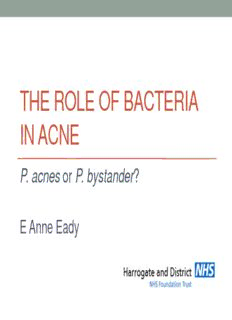
the role of bacteria in acne PDF
Preview the role of bacteria in acne
THE ROLE OF BACTERIA IN ACNE P. acnes or P. bystander? E Anne Eady Evidence based dermatology & basic research • No equivalent of the Cochrane Skin Group & associated systems for systematic identification/critical appraisal of evidence • Reviewers rarely rate evidence quality or challenge authors’ conclusions • Tendency to focus on what’s new • Few studies build on those that have gone before • It’s more fun to be first & easier to get funding for novel ideas • This review is ‘work in progress’ & a snapshot is presented here Identifying & appraising relevant articles PubMed [08 May 12] • Emphasis on in vivo data • 3689 P. acnes • Focus on topics addressed by at least 2 independent • 776 (21%) studies Propionibacterium AND acne • No date limit • 4077 C. parvum • Similar numbers dealt with microbiological v immunological aspects • 400 articles addressed the role of P. acnes in acne • ~150 selected for detailed • Also searched for alternative review hypotheses Proving a link between a microbe and a disease • Koch’s postulates • the microorganism should be present in every case of the disease • it should be isolated in pure culture & re-create the same symptoms of disease when inoculated into a new host • the isolate recovered from the new host should be indistinguishable from the original isolate • Problems • P. acnes is a member of the resident commensal flora of healthy skin (& mucous membranes) • Is it reasonable to expect every lesion to be colonised? Assumptions 1. Not all follicles are colonisable • SER exceeds maximum growth rate of P. acnes • Water activity too low • Niche already occupied • Antimicrobials of cellular origin may be present in inhibitory concs • Immune response may already be activated 2. Immune response is heterogeneous • More than one antigen • Innate & adaptive mechanisms involved & linked 3. Inflammation can occur via more than one pathway P. acnes: indisputable facts • Distribution & population densities on skin in acne and non-acne reflect location and number of sebaceous glands • Predominant micro-organism on face and trunk • Still present when acne regresses • A closely related organism, P. granulosum, has a similar distribution but lower prevalence • P. acnes is a potent adjuvant • Non-specifically up-regulates cellular immune responses to unrelated antigens P. acnes & inflammatory acne The balance of probability ? Innocent Guilty Immune response T cell mitogen Epidemiological evidence • Acne is a uniquely human disease • Pilosebaceous follicles are unique to human skin • P. acnes may be a uniquely human skin bacterium • P. acnes utilises glycerol obtained by hydrolysis of sebum triglycerides (TG) as a carbon & energy source • Human sebum contain more TG than any other species Microbiological evidence I Age-related changes in propionibacterial numbers on the skin surface: Leyden et al 1975 • Never repeated • Acne may be due to colonisation of immature follicles 7 6 2 m 5 c / Acne s 4 e n c 3 a Non-acne .P 2 g o L 1 0 11-15 y 16-20 y 21-25 y Microbiological evidence II Follicular distribution & population densities Healthy follicles Uninvolved follicles Closed comedones Open comedones 1-day papules 3-day papules (n = 77) acne (n = 138) (n = 28) (n = 28) (n = 50) (n = 19) % Geometric % Geometric % Geometric % Geometric % Geometric % Geometric colonised mean count colonised mean count colonised mean count colonised mean count colonised mean count colonised mean count 91 1.1 105 17 8.0 104 46 1.2 105 75 2.9 105 68 2.7 105 79 5.5 105 Data from Puhvel et al 1975 and Leeming et al 1988; Leeming’s data confirmed by Till et al 2002 10 other studies (1900 – 1979) examined lesions (mainly pustules & comedones) by histology or culture; prevalence of propionibacteria 64 – 100% Recent study using MAbs (Jahns et al 2012) found lower prevalence in acne (38%) but did not distinguish between uninvolved follicles & lesions
Description: